Preppy South Sea Pearl Brooch #103
$90
~pearls of wisdom~
“Love it felt like falling raindrop that scatters on a trembling leaf then roll off its tip in a cascade of pearls.” - Krishna Mira Prabhu
| Pearl Types | South Sea Pearls |
|---|---|
| Pearl Grade | A |
| Pearl Shape | Round |
| Pearl Size | 9.0-9.5 mm |
| Pearl Color | Gold |
| Metal Parts | Rhodium Plated |
| Brooch Size | 2 to 2.5 cm (1'') |
| Сontains | Clamshells |
5 in stock
- Rub the jewelry using a soft white cloth. If you find any black marks on the cloth, then you can be sure that it is made of real sterling silver. This is because any air exposure causes real sterling silver to oxidize. This causes them to deteriorate with time, and the reason why black marks are found on the cloth they are polished with.
- Do The Nitric Acid Test. When drops of nitric acid are added to fake non-silver jewelries, they cause them to lose their color. Always ask a jeweler before buying 925 sterling silver from him if you can conduct the nitric acid test on it. Nitric acid has no effect on real 925 sterling silver, so if the jeweler is selling you a genuine product, he won’t have any objection to that. But be sure to wear gloves and protect your eyes with goggles while doing the nitric acid test. If the jewelry is made of real sterling silver, the part on which you drop the nitric acid will appear creamy in color, otherwise, if fake, it will appear green.
- Use the Smell Test. Real sterling silver shouldn’t smell. If it does, it is because there is too much copper in it.
- Use the Magnet Test. This is a simple test. Magnets have no effect on silver – just as they have no effect on gold or platinum. But if you find that the jewelry is attracted to the magnet, then it will be clear to you that it is not made of real sterling silver.
- Real sterling silver jewelry will have markings such as “Ster,” “925” or “Sterling Silver” in a hidden area. If you don’t see such a marking, be wary of it immediately.
- Real pearls have fingerprint-like surface ridges when viewed under magnification. Fake pearls have bubbles or mat patterns on the surface when viewed under magnification.
- Real pearls have enriched body color and an overtone color. Fake pearls only have one body color. The color looks flat and lacks depth.
- Real pearls are cold to touch. You don’t feel the coolness when touching fake pearls.
- If you rub pearls across your teeth, real pearls feel gritty while fake pearls feel smooth.
- Real pearls are heavy. Fake pearls are light in weight.
- Real pearls show smoothness around drilled holes. Fake pearls show roughness or bumps around drilled holes.
- Luster - this makes or breaks pearls as a gemstone. Luster describes the way light reflects off the pearl surface (Sharp and Highly Reflective or Soft and Blurry). The sharper the Luster, the more valuable the pearl.
- Surface Quality - pearls with smooth, clean surfaces are more highly valued than those with multiple inclusions.
- The symmetry of Shape - truly round pearls are the rarest shape of all, and the most valued. After that, we look for perfectly symmetrical semi-baroque shapes like tear-drops and ovals, then circled baroques and finally, free form baroques which are totally asymmetrical.
- Color - pearls come in every color of the rainbow (literally!). This value factor is weighted according to whether the color is naturally-occurring, the depth and saturation of the color, and the rarity of the color.
- Size - large, perfectly symmetrical pearls are RARE, taking many years to form inside the oyster. If all other value factors are equal, the larger pearls will be the more valuable ones.
- Origin - The value of cultured (farmed) pearls that dominate the industry today vary by pearl type: Freshwater (least expensive), saltwater Akoya (mid-range), black Tahitian (mid to high-range pricing), and South Sea (highest). We also factor in whether the pearl is cultured or natural/wild. Natural pearls - pearls that are formed without any human assistance - are extremely rare and command premium pricing.
- Matching - The meticulous matching of a fine pearl necklace layout can take many years depending on the pearl type. You’re looking for a steady, smooth graduation rate from smallest to largest pearls in the center, with little to no variation from pearl to pearl in terms of Luster, Shape, Color, Overtone, and Surface Quality (Multi-Color strands are given a tad more leeway but still must have an overall well-matched "tone").
- AAA (Flawless): The highest-quality pearl, virtually flawless. The surface will have a very high luster, and at least 95% of the surface will be free from any type of defect. The pearl will be perfectly round and have a mirror-like luster, and a nacre thickness of 0.4mm or higher.
- AA (Excellent): The surface will have a very high luster, and at least 75% of the surface will be free from any type of defect. The luster will be very high, and have a thick nacre, still a very nice quality but not quite as nice as AAA or higher.
- A (Good): This is the basic jewelry-grade pearl, with a lower luster and/or less than 75% of the surface showing surface without any defects. In many cases, if the pearl is being mounted into a piece of jewelry, it can be mounted so that the defects are hidden - thus providing a lovely jewelry piece at a lesser price. This quality has a chalky appearance and thin nacre, typically of .25mm or less.
- Pearls can keep their luster for a very long time when cared for. Proper pearl care is not difficult, as long as you remember that these gems are organic by nature, grown in water from living cells of a living creature.
- The best way to help your pearls maintain their luster is to wear them regularly. Your body’s natural oils aid in maintaining the pearls’ beauty.
- Pearls should be worn alone. If worn with other jewelry, such as a gold chain or other necklace, they may be scratched or damaged.
- Apply any cosmetics, lotions, perfume, or hair spray before putting on your pearls. Make your pearls the last item you put on when getting dressed and the first item you take off.
- Avoid contact with salt water, chlorinated water, or perspiration.
- Wipe your pearls after wearing them, using a soft cloth.
- Remove spills immediately when pearls come in contact with any foods or liquids. Wipe them with a soft damp cloth and then with a dry soft cloth.
- Store your pearls separately from other jewelry, preferably in a cloth bag. Storing them in a slightly damp linen cloth will help the pearls from drying out in low humidity atmospheres and centrally heated areas.
- Never clean your pearls with soap, detergents, or jewelry cleaner. A harsh cleanser can wear away the nacre.
- Never use an ultrasonic jewelry cleaning machine or steam cleaner.
- Have your pearls restrung every two to five years if worn regularly, or when the silk becomes dirty? Take your pearls to a professional jeweler for cleaning before restringing, which will add to the beauty and long life of your pearls.
- According to legends, Adam and Eve cried deeply after God cast them out of the Garden of Eden. Their tears created a lake of pearls. It was believed that Eve’s tears created the white pearls, while Adam’s tears created the black pearls. Furthermore, it’s also said that Adam shed fewer tears than Eve did because men control their emotions better than women. Supposedly, this explains why black pearls are so rare.
- According to The Koran, the pearl can be found in Paradise. It’s one of the greatest rewards there. This precious gem is also now symbolic of perfection.
- Pearls symbolize purity to both Hindus and Christians. This is where the "brides wearing pearls on their wedding days" tradition is said to have started, which continues today.
- Because they symbolize religious purity, pearls became sacred objects to Christians by the Middle Ages. During early times, Christians believed the pearls that covered the Holy Grail purified its water.
- During Ancient Greek days, the myth was that pearls were the gods’ tears. It was also believed that if a woman wore pearls on her wedding day, it would stop her from crying.
- Hindu folklore is a bit different. It describes the gems as drops of dew that dropped from the sky during the nigh ttime, into the moonlit ocean. Pearl’s meaning behind the story of Krishna, AKA Vishnu, is believed to be one of the earliest accounts of weddings and pearls. It’s said that Krishna pulled the very first pearl from the sea. He then presented it to Pandaia, his daughter, on the day of her wedding. His wedding gift was a symbol of purity, love, and union.
- Ancient Polynesian myth - The god of fertility and peace, Oro, traveled on a rainbow to visit earth. He brought a magical oyster with him to the people of Polynesia called The Ufi. A gorgeous black pearl was formed inside The Ufi. When Oro said it, he gave it to Princess Bora Bora to symbolize his undying love.
- Ancient Japanese Legend – During ancient times, the Japanese believed that the tears of mythical creatures created pearls. Some of these creatures include, but are not limited to, nymphs, mermaids, and angels.
- Ancient Persian Legend – According to one Persian pearl myth, the gems were created after a storm. That’s when a rainbow came down from the sky and met with the earth. Lightning and thunder were said to be the reasons for the pearl’s imperfections.
- Ancient Egyptian Legend – During ancient times, Egyptians were buried with their pearls after they died because they valued you them so much. The myth from this era that’s most famous involves Cleopatra, the famous ruler of Egypt. Legend has it that she took the gem from one of her pearl earrings. She then dissolved it and drank it! Supposedly, this was done to show Roman politician Mark Antony that the entire nation’s wealth could be devoured in one, single gulp.
- Ancient Chinese Legend – Black pearls were very symbolic during early Chinese civilization. They were symbolic of wisdom. People believed the gems were formed inside the head of a dragon. Once they were fully grown, the dragon carried them between its teeth. According to the myth, a person could only gather the pearls by slaying the dragon to death.
***
our main resources: south sea pearls farm, workshop, and talented people
Conversion Tool: enter any value you want!
- Use the Conversion Tool to move between these different units of measurement.
- Enter a value into one field and the others convert automatically.
- See the Glossary for an insight on each unit of measurement.
- For a pearl each millimeter matters! Read an article below to understand why :)
Real Reason why each 1mm is so important for a Sea Pearl
Have you ever wondered whether it's worth going up a size when buying pearls (or other round beads)? The diameter of a pearl (its size in millimeters) doesn't tell the whole story and can be misleading when deciding what size pearls to buy. What really matters is not the diameter, but the volume.
We're often asked for advice when customers are trying to determine what size of pearl is best suited for them. The question is typically whether or not it is worth it to go up a size or two in millimeters. Is the difference really that noticeable?
The image below is of a 6 mm akoya pearl next to a 12 mm South Sea pearl. The millimeter size is exactly double, but it's easy to see that the true difference in size is much greater.
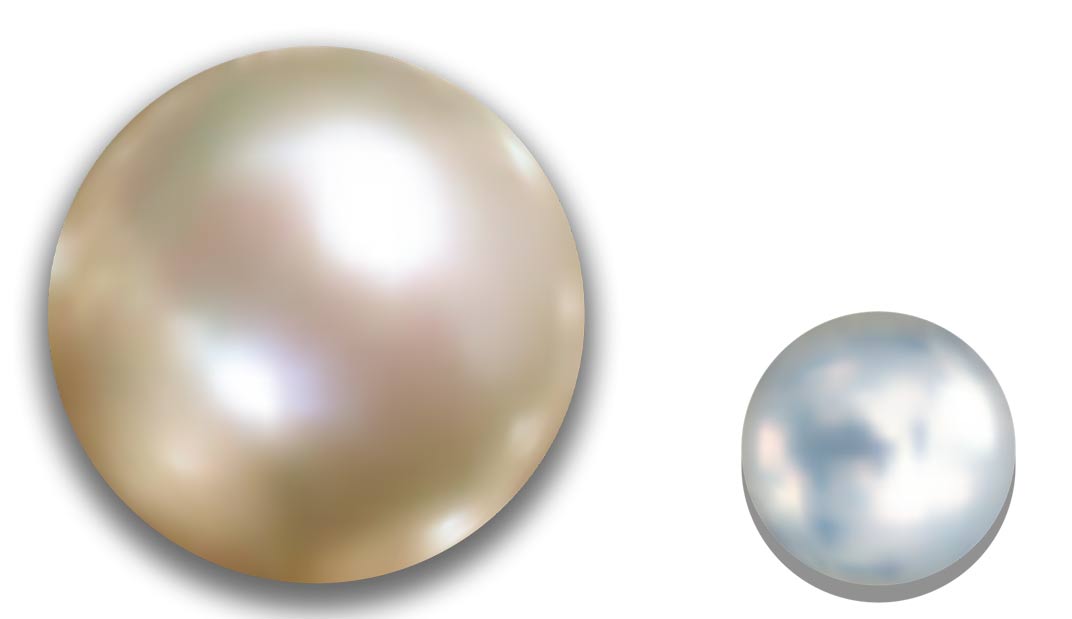
As a rule of thumb, I've always told customers that a 2 mm incremental increase in millimeter size would approximately double the overall size of the pearl. On the surface this tends to be confusing. How can an 8 mm pearl be twice the size of a 6 mm pearl?
The trick is that pearls are 3D odjects (not just flat circles on a page as they are pictured). Because of that their volume is all about the 3D size. It is about how much space pearls take up and how large their look. Their weight and visual impact.
Knowing the volume of a given pearl size lets you compare one size with another. It can tell how larger and heavier any pearl will be compared to another pearl. We could also use this to estimate out how much larger and heavier a strand may be compared to another strand.
We do this by dividing the volume of the larger pearl by the volume of the smaller pearl (or in the case of strands, dividing volumes of the end pearls of the 2 strands and the center pearls of the 2 strands, and then averaging).
Lets look into some examples. Take them as a guide to help you estimate how large a given size pearl is compared to another.
- 16mm pearl: 2144 cubic mm (21% larger than 15mm pearls, and over 3 times as large as 11mm pearls.)
- 15mm pearl: 1766 cubic mm (23% larger than 14mm pearls)
- 14mm pearl: 1436 cubic mm (25% larger than 13mm) (twice as large as 11mm, and over 5x as large as 8mm pearls)
- 13mm pearl: 1150 cubic mm (27% larger than 12mm)
- 12mm pearl: 904 cubic mm (30% larger than 11mm and 73% larger than 10mm; over 3 times as large as 8mm)
- 11mm pearl: 697 cubic mm (33% larger than 10mm)
- 10mm pearl: 523 cubic mm (37% larger than 9mm, 95% larger than 8mm)
- 9mm pearl: 382 cubic mm (43% larger than 8mm; 2 times as large as 7mm pearls)
- 8mm pearl: 268 cubic mm (49% larger than 7mm)
- 7mm pearl: 180 cubic mm (59% larger than 6mm)
- 6mm pearl: 113 cubic mm (74% larger than 5mm pearls)
- 5mm pearl: 65 cubic mm
Note: An increase of one millimeter makes more of a difference when the pearls are small than when they are large. (This is because 1mm is a greater percent of the total size of a small pearl than of a large one :)
Anyone can do such calculations for any pearl size. All we need is to found out a diameter. Lets do such magic trick to a 7mm pearl:
Volume (of a sphere) = 4/3 π (radius cubed)
- Divide the diameter in half to get the radius (the radius of a 7mm pearl is 3.5)
- Multiply the radius by itself, and again by itself to get the radius cubed (3.5 x 3.5 x 3.5 = 43, rounding it up)
- Then multiply the radius cubed by 3.14 (π, or "pi") (43 x 3.14 = 135)
- Now multiply that result by 4, and then divide by 3 (135 x 4 = 540, then divided by 3 = 180)
- The final result is the volume of that pearl in cubic millimeters, rounded off (7mm pearl is approximately 180 cubic mm)
The volume alone is not much useful, but it is important for comparing two pearls by their sizes so as to understand how larger or smaller they are.
To compare two pearl sizes, divide the volume of the larger pearl by that of the smaller one. Lets deal with two tasks:
Task number One: lets found out how much 8mm pearl is larger than a 7mm pearl?
We should start by dividing 268 cubic mm (volume of 8mm pearl) by 180 cubic mm (volume of 7mm pearl) = 1.49
Thus, 8mm pearls are 1.49 times as large as 7mm pearls, or stated differently, they are 49% larger by volume.
Another way to state this is that 8mm pearls will look about one and a half times as large as 7mm pearls and will weigh 1/2 times as much.
Task number Two: How much a 10-12mm strand is larger than a 9-11 mm strand?
A 12mm single pearl is 30% larger than a 11mm pearl, so the central pearls in a 10-12mm strand will be 30% larger.
A 10mm pearl is 37% larger than a 9mm pearl, so the smallest pearls in a 10-12mm strand will be 37% larger.
In averaged we got 37% and 30%, and an averag of that is 33.5%.
Soo we see, that 10-12mm strand will be about a one third time larger (and a third heavier) than a 9-11mm strand overall.
A 12-14mm strand will be two-thirds (66%) larger than a 10-12mm strand. And so on.
You can do similar calculations to compare any 2 strands, but it is just an estimate when it comes to strands, as some strands have a single, oversized central pearl, or only a few small pearls close to a clasp. Still my method can give you an idea of a relative size for any product you want to compare with each other.
Going up by just a little in terms of millimeters can definitely impact appearance and weight your pearl jewelry. If you are buying a rope, it's all the more important to consider the weight.
Custom Jewelry
***
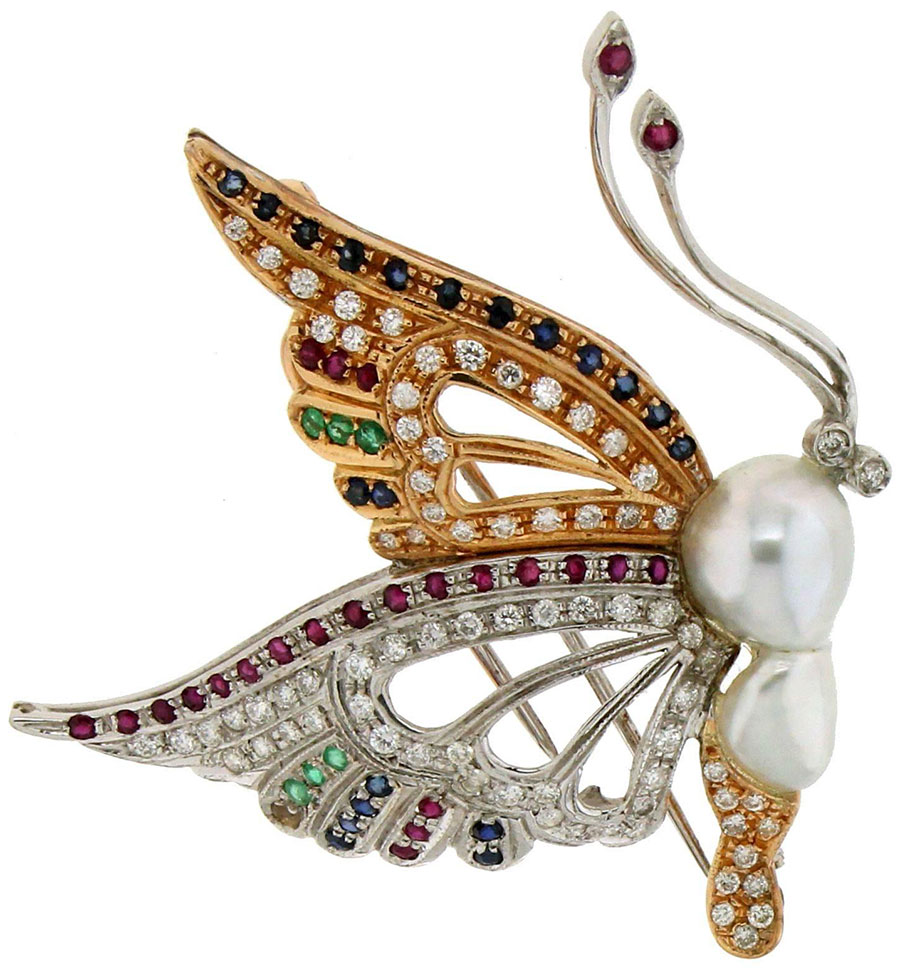
1) First thing first. You can customize any product we have the way you want. If you see an item of pearl jewelry in our shop and need a different length, color, shape, or size of a pearl, just ask. Maybe, you just need a white gold clasp instead of yellow or a different clasp design. Fair Pearls will be delighted to assist you. We have access to a wide range of pearls including the South Sea, Tahitian, and freshwater pearls that are not pictured on our website. With all kinds of shapes, sizes, and colors available, there will always be something to match your latest outfits.
Do you like silver more than gold? If yes, then we will make silver jewelry for you. Do you preferer something else? All custom designed jewelry is easy to order. Platinum, rhodium or 14K, 18K, 22K gold of any color, sterling silver - the choices are yours. Do you want the specific shape of pearls, like button, baroque, etc.? We will do as you ask. Are you need a gem of preferable color? We can offer white, cream, black, gold, or just slightly golden pearls and even more. South sea pearls we are farming by yourself, so can offer you a nice discount. Please contact us if you have any interest in developing a custom design.
2) Do you have a vision of the perfect pearl jewelry, ring, or bracelet, but you can’t seem to find exactly what you’re looking for? Have you always dreamed of designing your own pearl strands, but aren’t sure exactly how to go about creating custom jewelry? With Fair Pearls exclusive Make Your Own Treasure capabilities, you can have the pearl jewelry you’ve always wanted at a price you never knew was possible.
If you are asking for round south sea pearl to look square in a silver ring we can do that. We may suggest adding some custom details that might help make it your own and set it apart from anything else. Our designers will work with you on a personal custom design, making sketches building the exact design you have always wanted. Creating an original design with the style, details, colors, and shapes. Locating the perfect pearl could be part of the quest.
Please note that we usually do not undertake metalwork or precious stone designs for customs orders although we may be able to find something similar to your requirement if asked.
How to custom order :
- E-mail us with your requirements using our feedback form or the custom order quotation request form below. We will be delighted to evaluate and quote for your custom made pearl jewelry request free of charge with no obligation.
- Fair Pearls will e-mail you within 2-3 working days to refine and discuss your request
- You will usually receive an e-mailed quotation within 5 working days and we will advise you of the approximate anticipated delivery which is usually from a few days for stock items to 30-40 days for non-stock items
- If the quotation is accepted, please e-mail your acceptance to Fair Pearls to place a 50% deposit (non-returnable) by payment card. Please know, that we do not accept returns for custom-ordered pieces.
- Fair Pearls will undertake your custom order and will e-mail a photograph of either the components of your pearl jewelry or the finished product prior to dispatch for your acceptance and final payment
The idea for your custom jewelry you can take from many product Fair Pearls already published online, you can borrow design from favorite movies or encounter amazing idea for a completely unique piece of art in your dream. We can start to blend and bend lines combining many ideas together. Our crafter will build the original wax model with the requested details for you. Casting and adding the finishing touches to the jewelry piece, we will bring it to completion.
All custom designed jewelry is easy to order. Platinum, rhodium or 14K, 18K, 22K gold any color, sterling silver the choices are yours. Please contact us if you have any interest in developing a custom design.
With best regards,
Fair Pearls team
This past September Fair Pearls was contacted about creating a very special Custom Design Necklace for a client’s anniversary. Here is the original image he sent to us:
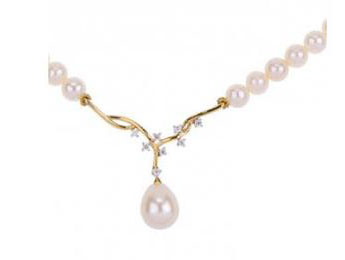
We immediately started to work! At first we created a pearl layout using 6.5-7.0 mm gems of elite quality Freshwater pearls, and used a gorgeous 9.0-10.0 mm Metallic White Freshwater Drop-Shape pearl for the dangle. That big “pop” the Drop Shape provides some nice weight for the center of necklace.
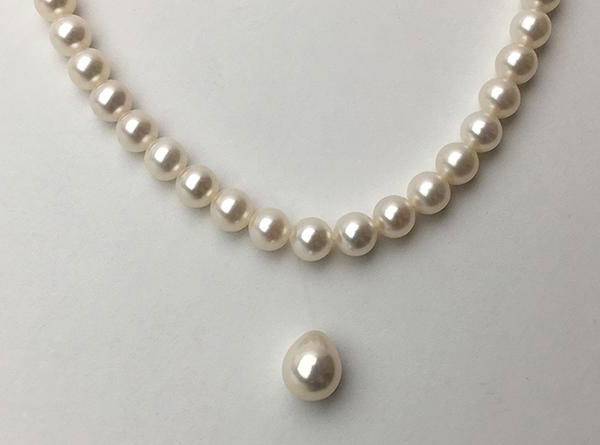
We also contacted local goldsmith we like to use for creating jewelry like this one, and he was able to create a full wax cast of the 18K Gold and Diamond branching center section:
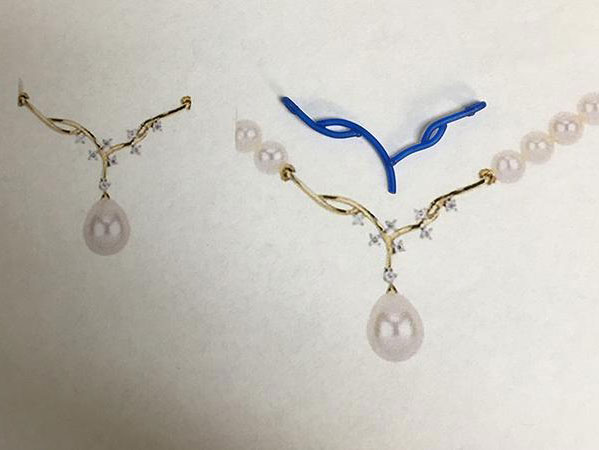
Next, he cast the entire piece in 18K Yellow Gold, and set the VS1-GH Quality Round Brilliant Diamond Accents (about 0.04cts each):
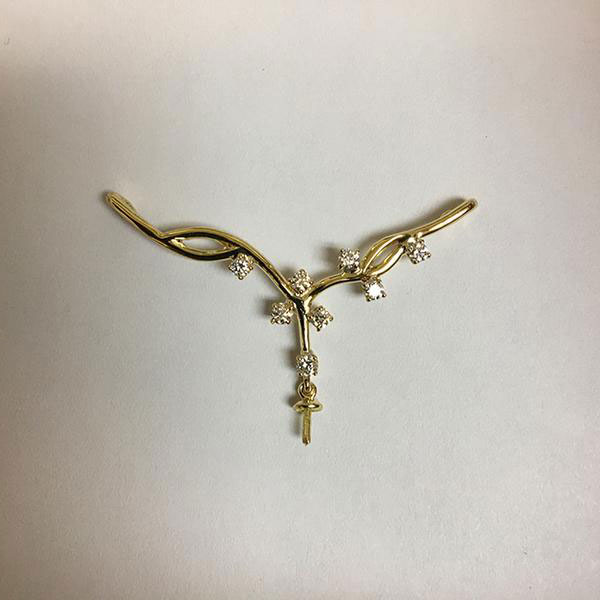
The center piece came back to me completed, at which point our stringer added on the pearl strand and center Metallic Drop and …. Voila!! The finished pearl necklace was ready to send! It was so pretty we made a couple of pictures to our collection…
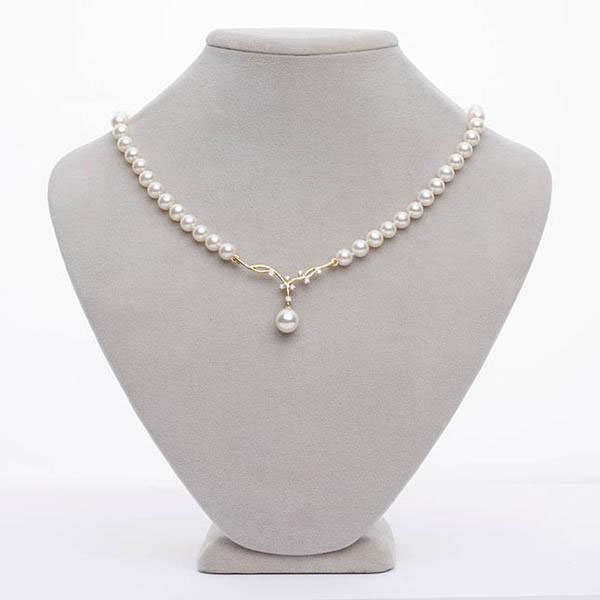
Here's a close-up of that STUNNING center section (doesn't that Metallic Drop just POP, or what?!):
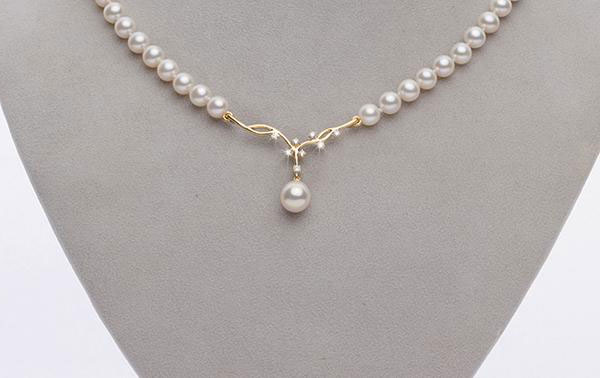
If you have a Custom Design or want to replicate a pearl treasure you’ve seen somewhere please contact Fair Pearl anytime – we just love to make dreams come true!
Specification for Preppy South Sea Pearl Brooch #103
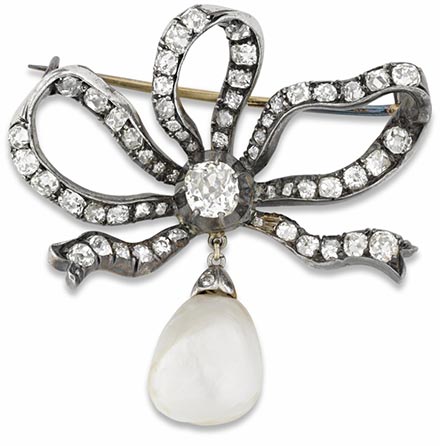
The Americans call brooches 'pins'. Take Madeleine Albright, the former US secretary of state - she has a collection of hundreds of pins, and when in government used them as a sort of avatar for her frame of mind. She wore butterflies and balloons on good days; insects on bad days and a snake in the aftermath of the Gulf War, when the Iraqi media dubbed her 'an unparalleled serpent'.
TIPS ON WEARING A BROOCH
- The more elaborate and unique the design of your brooch is, the more you will stand out.
- Make sure the fabric can manage the weight of the brooch you are wearing.
- Brooches and pins are more noticeable if they contrast with the background.
- Bright colored garments go best with black, dark-colored brooches. Silver and diamante brooches go best with black or dark colored outfit; if you really want your fashion brooch to stand out – remember this simple rule.
- Experiment with your brooches, and find new and unusual ways to wear them.
- Combine several commonly themed ones into a cluster.
- You should wear several strands of pearls and a brooch when going to the races. Take a lesson from the Queen Mother. She knew.
HOW AND WHERE TO WEAR A BROOCH/PIN
Dress / Brooch is a perfect accessory for any dress.
- Accentuate you bust lines by placing an attractive brooch at the bottom of the vee.
- Get that ladylike, demure look by accessorizing your little black dress with a strategically placed pearls in form of a flower.
- If your dress is too big - just gather the extra fabric in the back (like from the bust, because you need that to fit) and pin it with the brooch.
Lapel / Lapel is a traditional place to wear brooches and pins.
- This is the most versatile place where you can put pieces of any type, size or color. Let your imagination go wild and your personality shine!
- Combine several commonly themed ones into a cluster. Make a good use of the oversized, classic wreath, pearl or enamel, multicolored or charm brooches. There really are no limits!
Blouse or Shirt / Looking to complete the look?
- Place a medium sized geometric brooch near the collar of your shirt or a blouse, to join both ends of the fabric.
- Try matching or contrasting the brooch color to the color of your eyes.
Cardigan or sweater / Almost any cardigan welcomes to wear charm brooches.
- Sophisticated brooches with loads of elements, perhaps in boho style, will serve as a good decoration to your button top or a sweater.
- Also choose a Victorian or vintage pearl brooch.
Ponytail or Hair Bun
- To add a little sparkle to your ponytail attach a brooch to a plain ponytail holder and tie up your hair as you would normally do.
- If you put your hair up in a bun or French twist, secure the brooch or pin to a hair comb or a large clip. Easy, simple, yet totally stunning!
Bandana / If you wear bandanas, don't forget to decorate them.
- A gorgeous Pearl pin will emphasize your gorgeous hair.
- Choose any size, but make sure it's not too heavy to be a nuisance, pulling your bandana constantly to one side.
Gloves / If you are used to wearing large rings and have to wear gloves, choose a brooch instead.
- It will go nicely on the back of your glove wrist.
- Choose the brooch in the same way would choose a ring: large enough to attract attention, but small enough not to get in your way.
Hat or Beret / Re-define the look of your hat.
- Pick your favorite brooch and stick it onto your a plain-cultured hat to create a signature piece that looks great.
- For ones in crochet a pearl bow or your special brooch is a good match.
- The classic black beret takes another meaning when you colorize it with several pins.
- For a modest extra sparkle attach diamante brooch in matching colors.
Scarf / Accessorise your accessory.
- Scarves are known for their versatility of wearing: tie your hair, cover your head or neck, turn it into a skirt or even a top.
- Use a brooch to hold it in one piece and in it's place.
Jeans
- Add buckets of glitz and glam to your denims.
- South Sea Pearl jewelry will look good an any jeans. A brooch with multiple pearls provides an easy way to add a new emotion to your style.
- Funky brooches have their place on jeans also. Place them strategically to attract even more attention.
Shoes / Add an impressive, spangled look to your shoes.
- Attach plain-colored abstract brooches or funky multi-colored pins to the band or near the seam for rigidity, and you have an instant pair of jeweled footwear.
- Try different, but similarly styled brooches for the left and right shoe.
Skirt /Add interest to a plain skirt.
- A large floral brooch can make a big difference to your plain skirt. Place it in the middle or to your side, whichever suits the style.
- Look for floral enameled pins or classic pearl-style costume jewels.
Clutch, Bag or Purse / Do you have a fabric clutch or a bag that been lying around for a while?
- For your personal style, you can add pins and brooches to make it unique, but be sure to choose ones that are smooth on the top to avoid snagging with your bag.
- Accessorize any bag. Pick any bag or clutch and put your favorite brooch on it. Don't be afraid to experiment and be adventurous to create your own and unique style!
Other Ways to wear a brooch.
- Attach a chain or a cord to your brooch and voila! - you've got yourself a pendant! ...and don't be afraid of mixing metals.
- Some people even wear one as a ring, just pin it to a thin gold or silver ring - it will certainly attract attention!
- Yo may have a belt with a jewelled buckle, if not - attach a diamante brooch to your rather dull belt to transform it into a head turner. Use it with any loose, unflattering dress - it will suddenly take an hourglass shape with the addition of the glamourised belt.
- Try scattering several brooches over a jacket or a plain dress. Pin on a sleeve, another on a shoulder, yet another on the lapel and still another on a pocket.
- Wear a cluster of them placed strategically around the collarbone area of a jacket or a dress. Multiple brooches, though, should have some vague relationship, like flower or abstract shapes. Keep other accessories minimal: get rid of the necklace or wear only a simple one, earrings should not be too dominant or eliminate them completely.
- Pin a brooch at the bottom of a V-neck. This will draw the attention to your bust line.
- Add a special touch to your wedding or birthday cake. Attach a corsage or wreath brooch to the ribbon surrounding the cake to create extra peppiness.
- Affix it to your key chain.
- Secure it to your purse.
- Pin them on a cloth bracelet.
Now that you have plenty more ways to wear them - go and get yourself some more beautiful brooches from Fair Pearls!
| Brooch Length (inches) | Brooch Length (cm) | Style |
|---|---|---|
| 0.2 to 0.75'' | 0.5 to 2 | Tiny |
| 0.75 to 1'' | 2 to 2.5 | Extra Small |
| 1 to 1.5'' | 2.5 to 3.8 | Small |
| 1.5 to 2.5'' | 3.8 to 6.4 | Middle Size |
| 2.5 to 3'' | 6.4 to 7.6 | Large |
| 3 to 4'' | 7.6 to 10 | Extra Large |
| 4'' and more | 10 and more | Giant |
CERTIFICATE OF AUTHENTICITY AND WARRANTY
As we always claim, Pure Pearls offers the best and highest quality Pearl Jewelry at the most affordable prices in Indonesia, a country which is famous as №1 producer of South Sea Pearl in the world. The quality of our gems is comparable with any international standards of Pearl Jewelry Craft! That is why each pearl jewelry purchased from the Fair Pearls website is accompanied by a Certificate of Authenticity.
As well as ensuring the pearls origin, the Certificate is your warranty that the pearls you have purchased are Cultured Saltwater or Freshwater Pearls. We are offering such documents with absolute confidence since we ourselves grow, made, select, buy, and export our crafting materials from reliable sources directly.
To this date, there’s still no set, internationally agreed-upon grading scale for pearls. That means that pearl grading is subjective, depending on the seller you’re dealing with.FairPearls.com uses the A-AAA Grading Scale, which is a simple and straight forward grading system based upon specific percentages for attributes like surface blemishing, luster rating (the sharpness of reflections), color/overtone and shape, among others.
If in any case, the pearls mentioned in the bought certificate are not matching with what a Gem Testing Laboratory can testify to a buyer (if it is a fake pearl or there are Fresh Water pearls instead of South Sea Pearls), we will refund to such buyer all money he paid as fast as we can - in 14 days time maximum.
Please know, that we also provide a Warranty from the date of purchase against faulty workmanship. In such cases, we will replace any bought item no questions asked. Damage through misuse/accidental damage/user error and the like and re-stringing is excluded from our warranty policy.
If required, we are happy to provide a professional re-stringing service ourselves.
This Warranty is conditional upon the owner/user following the "Pearl jewelry care and maintenance" advice supplied on our website. You can find such information in the FAQ section (https://fairpearls.com/faq/). Pearl Jewelry is inherently delicate and extra care must be taken.
Please remember, that Fair Pearls must be informed in writing (email preferred) of any claims/suspected faults/defects and the like as soon as such information became known. Tampering with third party repairs/adjustments without Fair Pearls prior approval automatically invalidates the warranty and our liability in the matter. Regularly stocked items can be returned at no extra cost. Customized items may not be returnable.
INTERNATIONAL RETURNS
If you are returning a product to us from outside the Indonesia, please note that we do not cover the cost of international returns. To ensure your product is returned in refundable condition use the same shipping box the product was delivered in or that the product is cushioned and firmly secured in a box. If you experience difficulties such as loss of product, contact the shipping carriers directly to file for lost products.
RETURNS STEPS
To return an item back to us, follow our simple process:
- Send us an email our email . Please be sure to include your original order number. We will respond to your returns request via email within 7 business days.
- Package Your Return. Include your order number, and all original packaging and any certificates of Authenticity.
- Get a confirmation number on your shipping return so you can track its progress. We are not responsible for lost or damage of return shipments.
We must receive your returned items within 30 days of the original order date. We issue refunds in the form of payment used to make the original purchase.
Should you have any questions, feel free to contact our customer service team by e-mail. They will be happy to assist you.
WITHDRAWAL (REFUND)
Your return must meet all conditions below to be eligible for a full refund:
- The Item has not been worn and does not show any signs of use including but not limited to scratches, dents, stains or any other flaws.
- The original product seal is intact and has not been removed. (All non-engraved and engraved products are sent with a black string hang-tag attached to them. Please make sure that it has not been removed.)
- Your return parcel includes all complementary items such as the original gift box, certificates and other promotional items.
- The product has previously not been resized or modified.
- The product is not a special order that has been designed and/or produced to customer specification.
- The product has been returned to FairPearls.com within 60 days from the delivery of your order.
We will credit your original payment method, excluding delivery charges. Please note that it can take up to 10 working days for the funds to appear back in your account depending on your bank or card issuer. Shipping charges are non-refundable. All returns must include the billing name, address, and order number used when making the purchase and must be accompanied by a reason for the return. All returns must be in their original condition and packaging. If purchasing loose pearls and plan on returning them, please do not mount or string the pearls, as doing so will void the return policy.
Please review your return and information carefully; we will not be responsible for lost or misdirected or returns damaged due to poor return shipping package. If you paid via credit card, a credit will be issued upon the return of the product and will appear on your billing statement.
SHIPPING TO ALMOUST 200 COUNTRIES
We are proud to offer international shipping services. However, there are some locations we are unable to ship to. If you happen to be from one of those countries we will contact you.
Shipping time varies by location. These are our estimates:
| Location | *Estimated Shipping Time |
|---|---|
| United States | 7-15 Business days |
| Canada, Europe | 7-20 Business days |
| Australia, New Zealand | 4-10 Business days |
| Mexico, Central America, South America | 7-20 Business days |
For shipping purposes we use such companies as FedEx, DHL, JNE, Kantor Pos, etc.
We strive to get orders to our customers as quickly as possible, and we will do whatever possible to ensure a safe, speedy delivery.
In stock jewelries will be sent out within 48 hours of payment received (orders can only be shipped out on week days Mon- Fri ). During busy times of the year, it may take an additional day or two for a product to ship.
Made to order products and custom orders require 7-15 days to make before shipping.
Also do not forget about Covid19. The virus could still impact the delivery time, even if not as heavy as it was during March, 2020.
You will receive an email with a tracking number once your order is shipped. Remember, that for some shipping companies, it takes 1-2 business days for the tracking information to update on the system. If your order was placed more than 5 business days ago and there is still no information on your tracking number, please contact us.
All orders can be cancelled until they are shipped. If your order has been paid and you need to make a change or cancel an order, you must contact us within 12 hours. Once the packaging and shipping process has started, it can no longer be cancelled.
FairPearls.com is focused on pleasing every customer, so we will attempt to notify you if there are any unforeseen delays with your order. Please note that we may elect to use a different shipping method if we feel it is a better fit or is necessary to ship your order properly. Also, we are not responsible for any custom fees once the items have shipped. By purchasing our products, you consent that one or more packages may be shipped to you and may get custom fees when they arrive to your country. .
If you have any other questions, please contact us and we will do our best to help you out.
Reviews all around the shop:
Related products
Pearl Brooches
Pearl Brooches
Pearl Brooches
Pearl Brooches
Pearl Brooches
Pearl Brooches
Pearl Brooches
Pearl Brooches

































































































Read REVIEWS BELOW or write your own for “Preppy South Sea Pearl Brooch #103”